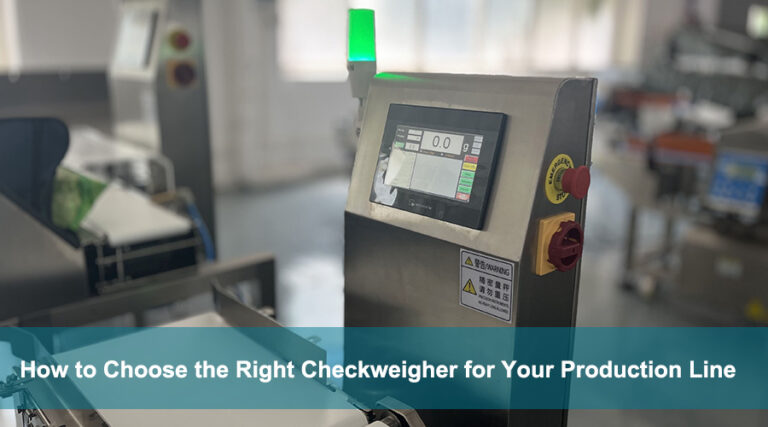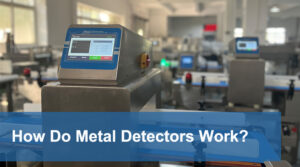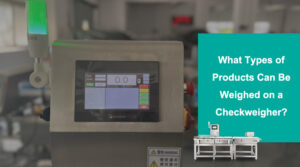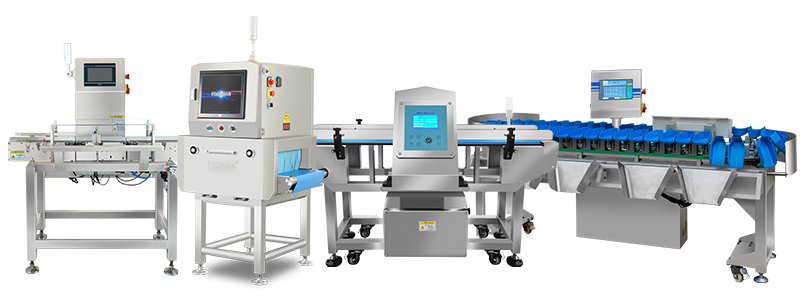Introduction
In manufacturing, accuracy and consistency are vital for product quality and compliance. A checkweigher is an essential tool for automatically verifying that each product meets its weight specifications. But with various models and configurations available, how do you choose the right check weigher for your specific production line?
This guide outlines key factors to consider when selecting a checkweigher system, including types, speed, accuracy, and integration with existing systems. Whether you’re in food packaging, pharmaceuticals, or consumer goods, this guide will help you select the right checkweigher for your needs.
Understanding the Basics of Checkweighers
Before diving into the specifics of how to choose the right checkweigher, it’s important to understand what it is and how it works.
What is a Checkweigher?
A checkweigher is an automated system in production lines that measures and verifies product weight for compliance with specifications. It offers high-speed weighing, ensures consistency, and reduces human error compared to manual methods.
How Does a Checkweigher Work?
A checkweigher machine operates by measuring the weight of products on a conveyor belt using a load cell. It compares the weight to a preset tolerance range (e.g., an ideal weight of 500 grams with a +/- 0.1 grams tolerance). If the weight is acceptable, the product continues on the production line; if not, an automatic reject mechanism (like a pusher or diverter) removes it.
Many check weighers are integrated with systems like metal detectors for enhanced quality control, ensuring products are accurately weighed and free from metal contamination.
Factors to Consider When Choosing the Right Checkweigher
Choosing the right checkweigher system depends on a variety of factors. Below are the most important ones to consider when evaluating your options.
a. Product Type and Size
When choosing a check weigher, consider the type of products you produce. Smaller items like pills or snack packs need precise checkweighing to avoid waste or compliance issues. In contrast, larger products such as cartons or industrial goods require machines that can handle heavier loads and bigger sizes.
b. Weight Accuracy and Tolerance
The accuracy of a checkweigher is crucial, as inaccuracies can lead to product waste, compliance issues, or customer dissatisfaction. The required accuracy varies by industry.
In food checkweighing, even small weight discrepancies can result in legal violations or customer complaints, necessitating high-precision systems. Pharmaceuticals and consumer goods manufacturing also demand precise measurements, with tolerances varying by product type.
Checkweighers should measure weight within a tolerance suitable for production needs, typically expressed in milligrams or grams.
c. Speed and Throughput
Production lines operate at high speeds, requiring checkweighers that can process large volumes quickly. For instance, food and beverage lines may need checkweighers capable of handling up to 1,000 products per minute. Matching the inline checkweigher’s speed with the production rate is crucial to prevent bottlenecks. Ensure the chosen checkweigher meets your throughput needs while maintaining accuracy.
d. Type of Reject Mechanism
A key feature of any checkweigher system is the reject mechanism, which removes products that don’t meet weight specifications. Options include:
Pneumatic rejectors: Use compressed air to push items off the line.
Air jets: Blow products off the line with powerful air.
The choice of mechanism depends on the product type; fragile items may need gentler methods like air jets, while durable products can be handled by pneumatic rejectors.
e. Integration with Other Systems
Modern checkweighers can enhance accuracy and efficiency by integrating with various quality control systems, such as:
Metal detectors: Identify metal contamination in food or pharmaceuticals.
Vision systems: Inspect packaging for defects and verify labeling.
Barcode scanners: Ensure product traceability and tracking.
f. Cost of the Checkweigher
Cost is a crucial factor when selecting an in line checkweigher. While budget options may seem appealing, it’s essential to consider performance as well. A cheaper checkweigher may lack the necessary speed, accuracy, and durability, potentially increasing long-term operational costs.
g. Maintenance and Support
Consider maintenance requirements and support options for the checkweigher. Choose machines that are easy to maintain and calibrate, and ensure the manufacturer provides reliable after-sales service, including training, spare parts, and quick support during downtime.
Types of Checkweighers
There are several types of check weighers designed for different production line requirements. Let’s explore the main categories to help you choose the right one for your line.
Checkweigher PC Series
The Easyweigh Checkweigher PC Series is more accurate and stable than the general checkweigher machine. It has a powerful self-learning function, making it convenient for staff to debug and simplifying the setup process.
High Speed & Accuracy Checkweigher
High speed checkweigher machine is designed for detecting small-weight packages items. It applies to various industries, including food, pharmaceutical, agriculture, and cosmetics; our checkweighers ensure precise and reliable results.
General Purpose Dynamic Checkweigher
The General Purpose Dynamic Checkweigher system detects weights from 1000g to 10kg, making it suitable for various production needs. It achieves exceptional accuracy with a precision of ±0.3g.
Maintenance and Calibration
To maintain the accuracy and efficiency of your checkweigher systems, regular calibration and maintenance are essential.
Calibration: A properly calibrated dynamic checkweigher ensures accuracy, as environmental factors and wear can affect performance. Many modern machines have automatic calibration, while others require manual adjustments. Establishing a routine for calibration can help avoid production delays.
Service and Support: Reliability also depends on minimal downtime. Choose a machine that offers strong after-sales support, including troubleshooting, spare parts, and on-site service.
Conclusion
Choosing the right checkweigher system is vital for the efficiency, accuracy, and profitability of your production line. Consider factors like product type, speed, weight accuracy, reject mechanisms, integration capabilities, and maintenance to ensure the best fit for your needs. Investing in the right checkweigher can enhance product quality, reduce waste, and optimize productivity.
FAQs
What is the difference between an inline and a standalone checkweigher?
An inline checkweigher is integrated directly into the production line for continuous operation, while a standalone checkweigher operates independently for batch or manual inspection.
Can dynamic checkweighers be integrated with other quality control systems?
Yes, modern check weighers can be integrated with systems like metal detectors, vision systems, and barcode scanners to improve overall quality control.
How accurate are checkweighers?
Dynamic checkweighers are highly accurate, with precision often down to milligrams, depending on the model. The accuracy required will vary based on the type of product being weighed.





